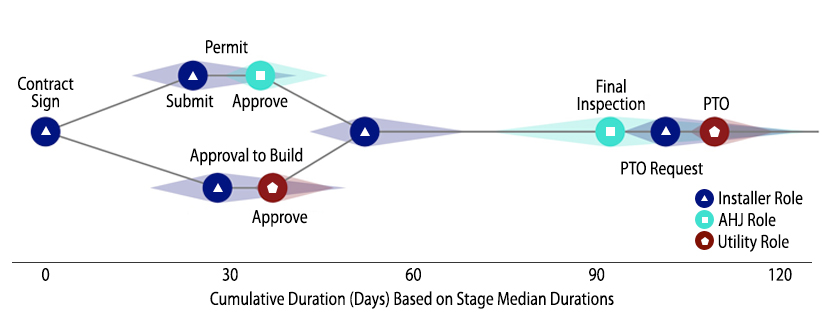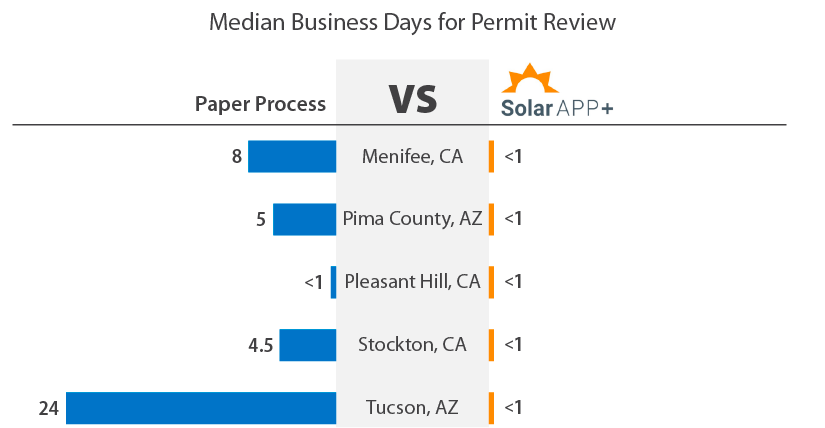Solar Permitting, Inspection, and Interconnection Timelines
To address solar permitting, inspection, and interconnection challenges and delays, NLR has developed software and analysis to identify best practices and streamline related review timelines.
For example, NLR's analysis of over 200,000 solar projects across the United States shows that adoption times vary widely. Even so, we find that adopting certain best practices such as instant, residential solar permitting can significantly reduce permitting review and overall adoption timelines. See Effects of Local Permitting and Interconnection Requirements on Solar PV Installation Durations, Energy Policy (2022).

Typical solar adoption process with installers, authorities having jurisdiction (AHJ), and utilities.
NLR's continued research in this space is designed to expand the use of identified best practices nationwide.
Distributed solar photovoltaic prices have plummeted over the past decade, but nonequipment “soft costs” such as permitting, inspection, and interconnection remain stubbornly high. Review and approval processes associated with the 20,000 distinct jurisdictions and 3,000 utilities can sometimes add weeks or months to the installation process, along with higher install costs that may be passed on to homeowners. These longer wait times can also increase the risks of cancellations, thereby passing even higher costs to successful sales.
SolarTRACE
In partnership with the solar industry, NLR developed SolarTRACE: Solar Time-Based Residential Analytics and Cycle time Estimator. This tool increases transparency into permitting, inspection, and interconnection process, requirements, and overall adoption cycle times nationwide. It includes median cycle times for over 1,500 jurisdictions with at least 10 installs in the data set, spanning 140 utilities and 26 states.
For more information about the tool, read the NLR news story
SolarAPP+
SolarAPP+: Solar Automated Permit Processing Plus is a free permitting platform that jurisdictions can adopt to improve permitting efficiency nationwide. This tool instantly reviews solar permits and is expanding to support more types of home energy systems. This software has reduced permit review times from as many as 20 business days to 0. This has resulted in projects being installed 12 days faster than those going through traditional permit review processes.

SolarAPP+ reduced the average permit review for AHJs to less than a day.
PRECISE: Preconfiguring and Controlling Inverter Set-Points
NLR’s Preconfiguring and Controlling Inverter Set-points, or PRECISE™, is a tool that seamlessly interconnects distributed solar energy, cutting wait time and costs for customers and their utilities.
PRECISE enables users to evaluate the feasibility and potential of solar energy. The tool analyzes the large data sets required for grid analysis, including solar energy output based off specific geographic and weather patterns, and quickly performs optimizations based off this data. It then suggests the optimal configuration for inverters. By estimating the potential solar output of a system and the impact of inverter configurations, PRECISE helps stakeholders make informed decisions on how to best maximize cost and energy efficiency.
Publications
SolarAPP+ Performance Review: 2023 Data, NLR Technical Report (2024)
Residential Solar Adoption Timelines and Impacts From the COVID-19 Pandemic, NLR Technical Report (2022)
Effects of Local Permitting and Interconnection Requirements on Solar PV Installation Durations, Energy Policy (2022)
Evaluating the Impact of Residential Solar Contract Cancellations in the United States, NLR Technical Report (2022)
A Retrospective Analysis of Distributed Solar Interconnection Timelines and Related State Mandates, NLR Technical Report (2022)
SolarAPP+ Pilot Analysis: Performance and Impact of Instant, Online Solar Permitting, NLR Technical Report (2022)
Contact
Share
Last Updated Dec. 24, 2025
